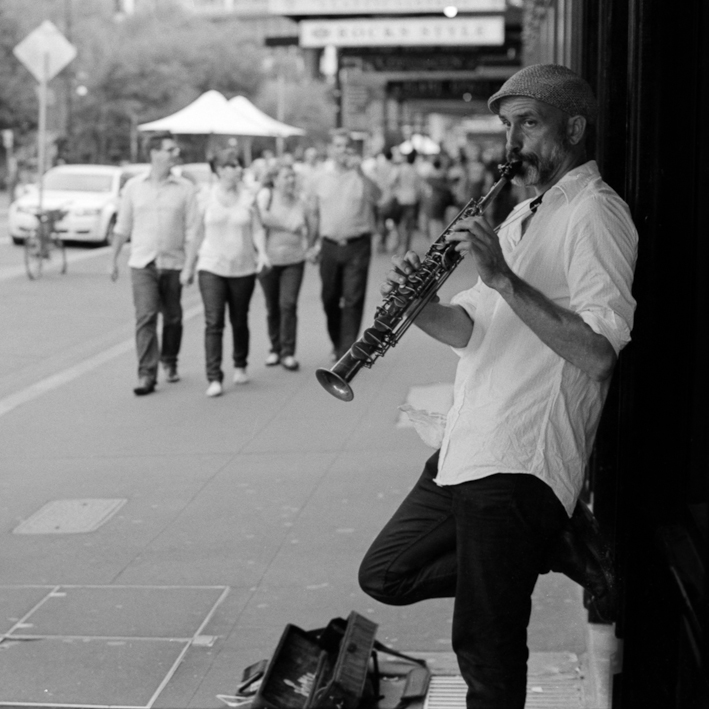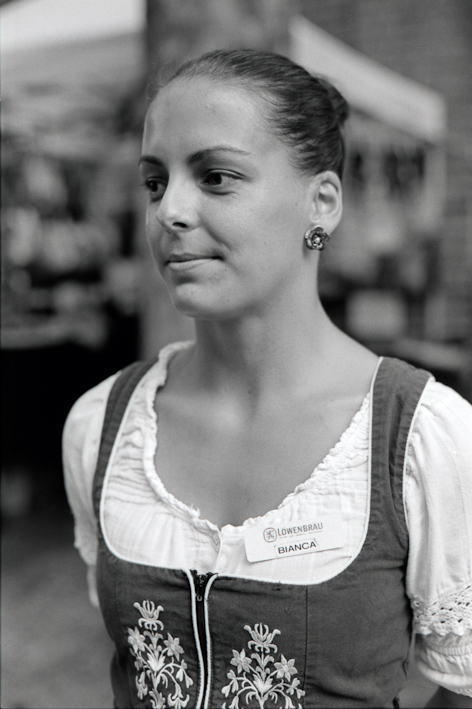My First Developed Roll
First contact sheet
When I first thought of starting a photography blog, I was trying to think of ways to differentiate its content from my Flickr Stream. So, I will post my contact sheets and look at five images off the roll to discuss why I took the shot, what I like about it, or what I should have done in hindsight.
This is the first roll of Black and White film I ever developed back in February this year (2011). This year, I promised to try to take my photography to the next level. One of the things I decided to do was take a class and learn something new. The Australian Centre of Photography had an open day where you could go in and discuss what courses they were offering. They forgot to mention that there was a test to determine how much technical knowledge you had about photography before discussing what classes were options for you. After passing the test, I enrolled in Process, Proof & Scan; I had already been shooting some colour film, so Black and White was the obvious next step.
The course was run by Michael Waite ( Flickr, Blog), who happens to be a great guy and very knowledgeable about all things film. I really enjoyed the course and hope to go back soon to do the follow-up course, Black & White: Print, later this year.
For the first class, we were asked to shoot a roll of film to process. They suggested Kodak Tri-X, so to keep things simple, I chose that and have since fallen in love with it. It was also suggested to try shooting in different types of light and bracketing some shots so you can see what it looks like on film, as working with film is really a two-step process: capture and development.
The film used was Kodak Tri-X with EI400 (exposure index) and was developed in XTOL 1:1 for 9 minutes at 20.5 C with agitation for the first minute and then for 10 seconds every minute. I used water as a stop bath, Kodak Rapid Fixer for 5 minutes, and Hypo Clear for 2 minutes before the final water wash.
Later, I will go into more detail about film development. When you develop film, there are a couple of important variables: film speed (ISO), exposure index (EI), developer used, time, temperature, and agitation. Different combinations will give you different aesthetic looks.
The white marks on the contact sheet are from when the film was in contact with itself, so the developer got stuck on that part of the film. I was in a rush to load the film and force it on to the real, which caused some of the film to buckle and jump out of the groove.
Geometric Shapes at Sydney Uni
This was taken just off the main walkway at Sydney Uni. I initially found this while looking for an exciting piece of architecture for an online competition last year. The solid geometrical shapes of the triangles and circles attract me to this location, with the strong, bold lines and smooth curves of the circles. The other thing I like about the location is the different textures of each surface.

A cool Jazz Cat
Of all the people on the street, I find buskers and musicians the easiest ones to approach. I always walk up and drop a couple of dollars before even asking to take their photograph. I think it tells them that I appreciate who they are and the music they are making. Normally, if they are playing, I will just motion to my camera with a smile. If they smile or nod back, I will take the shot. If not, walk away.
As you can probably tell from the contact sheet, I have cropped out the couple walking by. The original idea included someone walking by to fill the space on the left. However, this couple spotted me and either tried to be friendly and get out of frame or did not want to take their shot. I am happy with how it turned out, though, with how he leaned against the wall and looked out towards me. After seeing how that couple reacted, I don't think he would have been too happy if I hung around scaring everyone away, so I moved off.

Bianca
She was just around the corner from the Jazz player in the middle of her shift working at the Löwenbräu bar in Sydney as a waitress on the outside tables. It is also the first time I have ever walked up to someone and asked to take their photograph outside of street musicians. I was a little bit nervous and made a bit of a meal of it, but she did not say no. She is a lovely woman. I like how smooth her skin and the detail of her uniform turned out.
Every time I see this shot, I see her trying to look anywhere but this crazy guy with an old Nikon F3 camera. What I really should have done was try to get her to look at me to get some more light into her eyes.
Feel the Cords
This was taken just 100m further down the road from Bianca. He was a warm-up act to the band that was setting up behind him. I started by trying to take a shot of him playing with the audience watching (100 people), but after I took that shot, I remembered Capa's quote that you always need to get closer. So I headed right down to the front, sat on the ground, and waited for about 5 minutes, listening to some great classical guitar music for the guys setting up to move out of frame.
Looking back on it now, I like the expression on his face, the concentration, the feeling of the music, and the slight movement of his foot as he keeps the beat. But I wish I had captured his hands in a slightly better position.
The Problem Frame
Sometimes, everything goes wrong. This is a Frame in point. This was originally going to be a nightscape of Cronulla beach like the previous shot but one stop longer. But the batteries died—yep, it can even happen in some of the old SLRs. So I gave up for the night, forgetting that I had another set of batteries in the other camera until I got back to the train station. You can see some of the lights of the buildings.
While waiting for the train to head home, I took another shot at the train station. So I put in the set of batteries from the other camera, and, so as not to waste the frame, used the multiple exposure feature to cock the shutter while not advancing the film, took the shot and thought it was all ok. Oops, I had forgotten to turn the nob back to normal film progression, so when I wound on, I had not advanced the film but only readied the camera for the next shot.
At the time, I was trying to capture the final image of the architecture of the building and him washing his face, but I wish Capa's quote came to mind here as I think the actual shot was to get up real close instead of hiding at the entrance of the alleyway. It could have had a real timeless quality as it was the middle of summer during a hot spell, but it could have been taken in any era by his act and what he was wearing with that building as a backdrop.





